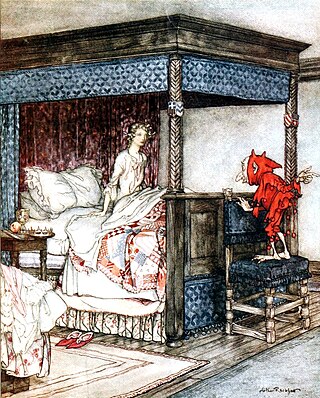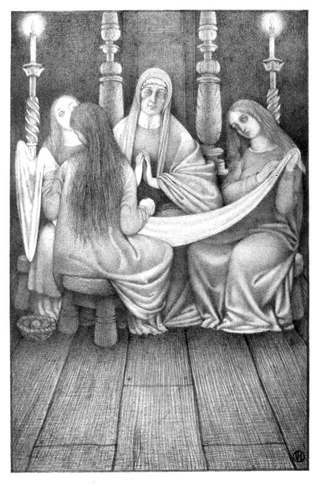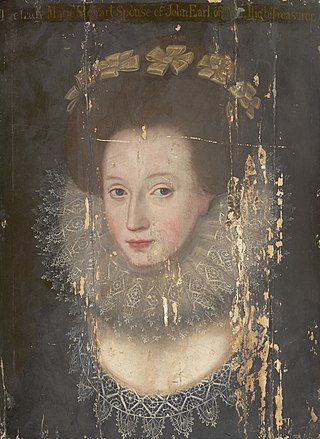Related Research Articles

Billy Blind is an English and Lowland Scottish household spirit, much like a brownie. He appears only in ballads, where he frequently advises the characters. It is possible that the character of Billy Blind is a folk memory of the god Woden or Odin from Germanic mythology, in his "more playful aspect" and is speculated to have been the same character as Blind Harie, the "blind man of the game" in Scotland.
"Lady Isabel and the Elf Knight" is the English common name representative of a very large class of European ballads.
Willie's Lady is Child ballad number 6 and Roud #220. The earliest known copy of the ballad is from a recitation transcribed in 1783.

"Young Beichan", also known as "Lord Bateman", "Lord Bakeman", "Lord Baker", "Young Bicham" and "Young Bekie", is a traditional folk ballad categorised as Child ballad 53 and Roud 40. The earliest versions date from the late 18th century, but it is probably older, with clear parallels in ballads and folktales across Europe. The song was popular as a broadside ballad in the nineteenth century, and survived well into the twentieth century in the oral tradition in rural areas of most English speaking parts of the world, particularly in England, Scotland and Appalachia.
"Kemp Owyne" is Child Ballad number 34.
Fair Annie is Child ballad number 62, existing in several variants.

"Lord Thomas and Fair Annet", also known as "Lord Thomas and Fair Eleanor", is an English folk ballad.
Fause Foodrage is a Scottish murder ballad of the 17th or 18th century. It was first printed by Walter Scott in Minstrelsy of the Scottish Border (1802). Scott cited Elizabeth, Lady Wardlaw as the ballad's probable author.
"Clerk Colvill" is Child ballad No. 42, otherwise known as "The Mermaid".
The Bonny Birdy is Child ballad 82.
"Gil Brenton" is Child ballad 5, Roud 22, existing in several variants.
Sweet William's Ghost is an English Ballad and folk song which exists in many lyrical variations and musical arrangements. Early known printings of the song include Allan Ramsay's The Tea-Table Miscellany in 1740 and Thomas Percy's Reliques of Ancient English Poetry in 1765. Percy believed that the last two stanzas of the version he published were later additions, but that the details of the story they recounted were original.
Clerk Saunders is Child ballad 69. It exists in several variants.
The Earl of Errol is Child ballad 231, existing in several variants. Sometimes the ballad is called Lady Errol.
Lord Thomas and Lady Margaret or Clerk Tamas (and Fair Annie) (Child ballad # 260; Roud # 109) is a traditional folk song.
The Twa Knights is a traditional Scottish ballad. It was collected by Francis James Child as Child ballad number 268. It is highly possible that the ballad was popularly unknown in Scotland, and only known through print. It has since been given the Roud number of 303.
"Elveskud" or "Elverskud" is the Danish, and most widely used, name for one of the most popular ballads in Scandinavia.
Jean Fleming, Countess of Cassilis (1553/4–1609) was a Scottish noblewoman and courtier at the court of James VI of Scotland, and a survivor of domestic violence.

Marie Stewart, Countess of Mar (1576-1644) was a Scottish courtier. She was the daughter of Esmé Stewart, 1st Duke of Lennox, a favourite of James VI of Scotland, and Catherine de Balsac. After her marriage, as was customary in Scotland, she did not change her name, and signed her letters as "Marie Stuart".

Margaret Vinstarr, was a Danish or German courtier in Scotland to Anne of Denmark commemorated by the ballad "The Laird o Logie" for rescuing her imprisoned lover.
References
- Citations
- ↑ Child (1892), Vol. 4, Part 2, 409.
- 1 2 Child (1885), Vol.2, Part 1, p. 69.
- ↑ Buchan (1828), pp. 313–314 (notes.
- ↑ Child (1892), Vol 4, Part 2, p. 409-.
- ↑ Buchan (1828), pp. 313–314.
- ↑ Gruntvig, Sven (1890). "255. Slegfred og Brud". Danmarks gamle folkeviser. Vol. 5. p. 1.
- ↑ Gruntvig, Sven; Jón Sigurðsson; Pálmi Pálsson, eds. (1885). "48. Elja kvæði". Íslenzk fornkvæði. Vol. 2. pp. 104–131.
- 1 2 Syndergaard (1995), English Translations of the Scandinavian Medieval Ballads, Appendix B: Scandinavian Ballads with Cognates in English, p. 241-242
- ↑ Jonsson, Bengt R., et al. (1978), The Types of the Scandinavian Medieval Ballad, p. 148
- ↑ Child (1885), Vol.2, Part 1, p. 65-66: for a summary of the Danish version
- ↑ Prior tr. (1860),"148. Fair Anna", Ancient Danish Ballads, Vol. 3, p. 298
- Bibliography
- Buchan, Peter (1828). "Thomas o' Yonderdale". Ancient Ballads and Songs of the North of Scotland. Vol. 1. W. & D. Laing, and J. Stevenson. pp. 221–226. = Child's 253a.
- Child, Francis James (1892). "253. Thomas o Yonderdale". The English and Scottish Popular Ballads. Vol. 4, Part2 (=Part VIII). Houghton, Mifflin. pp. 409–411.
- Child, Francis James (1885). "62. Fair Annie". The English and Scottish Popular Ballads. Vol. 2, Part1 (=Part III). Houghton, Mifflin. pp. 63–82.